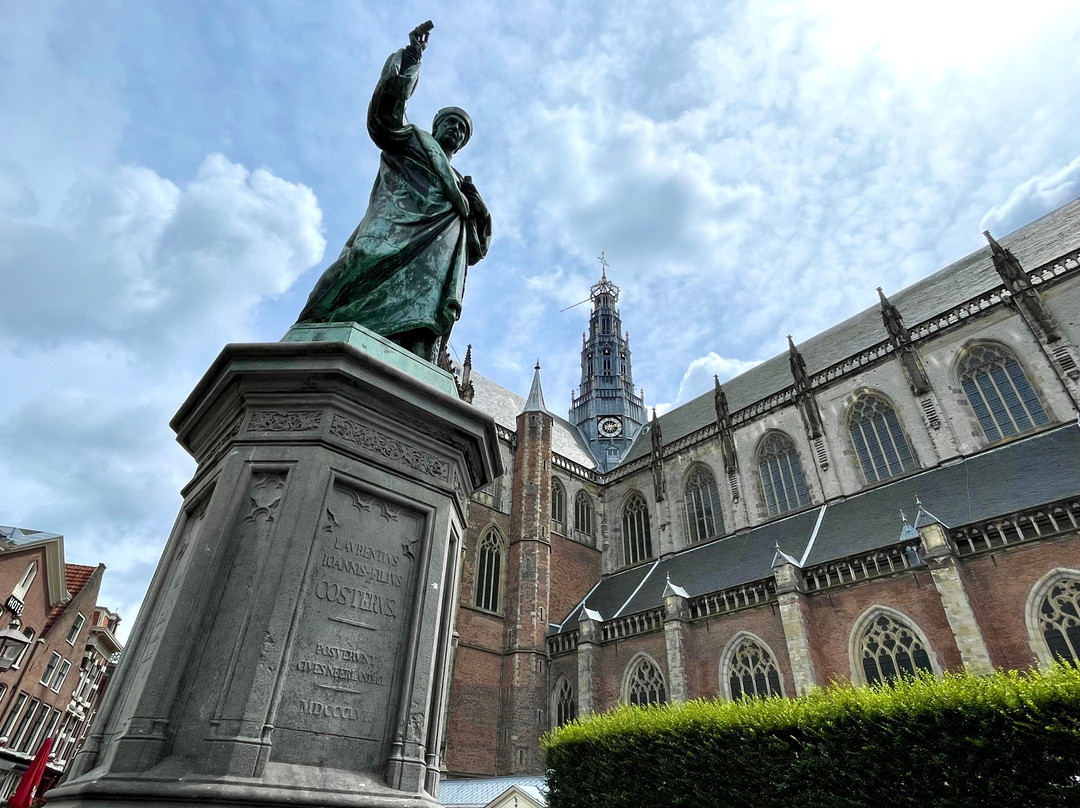的点评
Did He Beat Gutenberg to the Invention of the Printing Press?
Beeld Laurens Janszoon Coster的点评
点评:This central statue right outside the Great Church of St Bavo, is a monument to Laurens Coster, the 15th century Dutch printer who (according to the Dutch), was the real inventor of the printing press.
Outside of the Netherlands, Coster doesn’t get much credit. It’s generally accepted that the German,Johannes Gutenberg, invented the printing press in the 1440s.
In this digital age, it can be hard to realise just how absolutely revolutionary the printing press was.
Knowledge is power as they say and the printing press meant that knowledge, information, ideas and discoveries could be spread quickly, cheaply, and on a large scale.
Instead of tedious and time-consuming hand writing of manuscripts, the printing press allowed for mass-production of pamphlets, tracts and books.
Information could now be shared and sent around the known world.
Of course not many people could actually read but literacy improved over time and language become more standardised.
Whether it was Gutenberg or Coster who got there first, it is hard to know but regardless, this is an impressive statue which dominates the square.
Coster stands on a tall pedestal and behind him, the church’s towering 50m-high steeple looms large. Over the years, the bronze has acquired a beautiful green patina.
Coster clutches a book in his left hand, holding it close to his heart, and in the other hand, he holds up a small print block. I believe that the block is the letter “A” although I read that somewhere (the block itself is way too small and too high up to see clearly).
Outside of the Netherlands, Coster doesn’t get much credit. It’s generally accepted that the German,Johannes Gutenberg, invented the printing press in the 1440s.
In this digital age, it can be hard to realise just how absolutely revolutionary the printing press was.
Knowledge is power as they say and the printing press meant that knowledge, information, ideas and discoveries could be spread quickly, cheaply, and on a large scale.
Instead of tedious and time-consuming hand writing of manuscripts, the printing press allowed for mass-production of pamphlets, tracts and books.
Information could now be shared and sent around the known world.
Of course not many people could actually read but literacy improved over time and language become more standardised.
Whether it was Gutenberg or Coster who got there first, it is hard to know but regardless, this is an impressive statue which dominates the square.
Coster stands on a tall pedestal and behind him, the church’s towering 50m-high steeple looms large. Over the years, the bronze has acquired a beautiful green patina.
Coster clutches a book in his left hand, holding it close to his heart, and in the other hand, he holds up a small print block. I believe that the block is the letter “A” although I read that somewhere (the block itself is way too small and too high up to see clearly).
翻译:这座位于圣巴夫大教堂外面的中央雕像是劳伦斯·科斯特的纪念碑,他是 15 世纪的荷兰印刷工(根据荷兰人的说法),是印刷机的真正发明者。
在荷兰以外,科斯特并没有得到太多赞誉。人们普遍认为,德国人约翰内斯·古腾堡在 15 世纪 40 年代发明了印刷机。
在这个数字时代,很难意识到印刷机的革命性有多大。
正如人们所说,知识就是力量,印刷机意味着知识、信息、思想和发现可以快速、廉价地大规模传播。
印刷机使小册子、传单和书籍的批量生产成为可能,而不再需要繁琐而耗时的手写手稿。
信息现在可以在已知的世界中共享和发送。
当然,并不是很多人真正会读书,但随着时间的推移,识字率提高了,语言也变得更加标准化。
很难知道是古腾堡还是科斯特先到达那里,但无论如何,这尊令人印象深刻的雕像主宰着广场。
科斯特站在高高的基座上,在他身后,教堂高耸的 50 米高的尖塔若隐若现。多年来,青铜雕像已呈现出美丽的绿色光泽。
科斯特左手紧握着一本书,将其放在心上,另一只手拿着一个小的印刷块。我相信这个印刷块是字母“A”,尽管我在某个地方读到过(印刷块本身太小,太高,看不清楚)。
在荷兰以外,科斯特并没有得到太多赞誉。人们普遍认为,德国人约翰内斯·古腾堡在 15 世纪 40 年代发明了印刷机。
在这个数字时代,很难意识到印刷机的革命性有多大。
正如人们所说,知识就是力量,印刷机意味着知识、信息、思想和发现可以快速、廉价地大规模传播。
印刷机使小册子、传单和书籍的批量生产成为可能,而不再需要繁琐而耗时的手写手稿。
信息现在可以在已知的世界中共享和发送。
当然,并不是很多人真正会读书,但随着时间的推移,识字率提高了,语言也变得更加标准化。
很难知道是古腾堡还是科斯特先到达那里,但无论如何,这尊令人印象深刻的雕像主宰着广场。
科斯特站在高高的基座上,在他身后,教堂高耸的 50 米高的尖塔若隐若现。多年来,青铜雕像已呈现出美丽的绿色光泽。
科斯特左手紧握着一本书,将其放在心上,另一只手拿着一个小的印刷块。我相信这个印刷块是字母“A”,尽管我在某个地方读到过(印刷块本身太小,太高,看不清楚)。

此点评仅代表旅行者个人的主观意见,并不代表TripAdvisor以及其合作方的意见。
关于我们
|
新闻动态
|
商务合作
|
会员中心
|
业主中心
|
业主通
|
常见问题
|
意见反馈
|
联系我们
|
营业执照
© 2025 Tripadvisor 版权所有。
使用条款 |隐私政策 |网站工作原理
部分照片由 VFM Leonardo 提供。
* Tripadvisor不是旅行社,也不是旅游预订服务代理商。我们提供免费、客观、公正的旅游资讯服务。 (显示更多)
TripAdvisor LLC 既不是预订代理商,也不是旅游运营商,不会向网站用户收取任何服务费。 按照规定,在 Tripadvisor 发布机票价格、游览和旅行套餐的合作伙伴(航空公司、旅行提供商及预订代理商),其标价须包含所有费用和附加费用。 例如, 机场出入境税费、消费税与其他服务费、手续费、杂费及附加费用。 当您向我们的某个合作伙伴进行预订时,请务必查阅他们的网站以了解当地行政部门要求的所有适用费用的具体情况。 除非另有说明,机票价格通常指的是一个人的价格(以人民币计)。
为方便起见,TripAdvisor LLC 根据从我们的预订合作伙伴获取的空房率计算每个酒店的均价。 对于游览和景点来说,所显示价格通常是每位成人的最低可用价格。 对于列出的任何旅行套餐或优惠,TripAdvisor LLC 无法保证任何特定的费率或价格。 此外,酒店均价每晚会更新,并以您的首选币种表示(使用现行汇率)。 由于这些已换算的价格是预估价格,因此,有关具体金额和币种请与预订网站进行核实。
此外,TripAdvisor LLC 无法保证我们网站上宣传的价格随时有效。 标价可能需要预订一定天数才能生效,或有不可用日期、使用条件或限制。
TripAdvisor公司对外部网站的内容一概不负责。优惠价格中不含税和其他费用。
ICP证:沪B2-20200433
沪ICP备20013175号
 沪公网安备31010502005427号
沪公网安备31010502005427号鹰程信息技术(上海)有限公司
货币/国家及地区
¥CNY
中国

